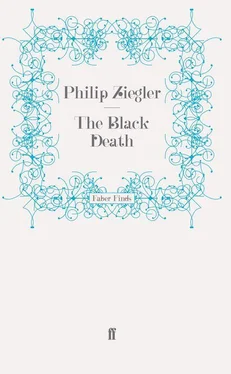5. GERMANY: THE FLAGELLANTS AND THE PERSECUTION OF THE JEWS
BY 1350, the plague in France had ended or, at least, so far abated as to make possible the holding of a Council in Paris to tighten up some of the laws against heresy. But in the meantime it had moved eastwards into Germany. Central Europe was thus attacked on two sides or if, as seems probable, the Black Death also advanced by land through the Balkans, on three sides more or less simultaneously. By June 1348, it had already breached the Tyrolese Alps and was at work in Bavaria, by the end of the year it had crept up the Moselle valley and was eating into North Germany. {152} 152 1 Lechner, Das Grosse Sterben in Deutschland, Innsbruck, 1884, p. 26.
In Styria, which it reached in November 1348, it seems to have been especially ferocious. According to the Neuburg Chronicle {153} 153 2 ‘Continuatio Novimontensis’, Mon. Germ., IX, p. 675.
even the wild animals were appalled at its depredations. ‘Men and women, driven to despair, wandered around as if mad… cattle were left to stray unattended in the fields for no one had any inclination to concern themselves about the future. The wolves, which came down from the mountains to attack the sheep, acted in a way which had never been heard of before. As if alarmed by some invisible warning they turned and fled back into the wilderness.’ In Frankfurt-am-Main, where Günther Von Schwarzburg died in the summer of 1349, two thousand people perished in seventy-two days. {154} 154 3 G. Rath, CIBA Symposium, III, 1956, p. 195.
In December 1349 the first case was recorded in Cologne. Six thousand died in Mainz, eleven thousand in Munster, twelve thousand in Erfurt. {155} 155 4 G. Sticker, Die Geschichte der Pest, Giessen, 1908, p. 68.
Nearly seven thousand died in Bremen in four parishes alone.
Vienna was visited from the spring to the late autumn of 1349. Every day, wrote Sticker, five to six hundred people died; once nine hundred and sixty perished in a single day. A third part of the population was exterminated, says one record; {156} 156 5 ‘Kalendarium Zwetlense’, Mon. Germ., IX, p. 692.
only a third survived says another. {157} 157 6 ‘Continuatio Novimontensis’, op. cit., p. 675.
The population identified the plague as the Pest Jungfrau who had only to raise her hand to infect a victim. She flew through the air in the form of a blue flame and, in this guise, was often seen emerging from the mouths of the dead. {158} 158 7 Crawfurd, Plague and Pestilence, op. cit., p. 125.
In Lithuanian legend the same plague maiden waved a red scarf through the door or window of a house to infect its inhabitants. A gallant gentleman deliberately opened a window of his house and waited with his sword drawn till the maiden arrived. As she thrust in the scarf he chopped off her hand. He died but the rest of the village escaped unscathed and the scarf was long preserved as a relic in the local church. {159} 159 8 L. Porquet, La Peste en Normandie, Vire, 1898, pp. 18–19.
In some areas the plague poison was believed to descend as a ball of fire. One such ball was fortunately spotted while hovering above Vienna and exorcized by a passing bishop. It fell harmlessly to the ground and a stone effigy of the Madonna was raised to commemorate this unique victory of the city’s defensive system.
The details of the daily horrors are very similar to those in the cities of Italy and France and there is no need to labour them again. One point of difference is the abnormally large number of churchmen who died during the epidemic. It seems indeed that the plague fell with exceptional violence on the German clergy; because, one must suppose in the absence of other explanation, of the greater fortitude with which they performed their duties. Conrad Eubel, basing his calculations almost entirely on German sources, {160} 160 9 Hierarchia catholica, Vol. 1, Münster, 1913, cit. Campbell, p. 134.
shows that at least thirty-five per cent of the higher clergy died in this period. The figure would not be exceptionally high if it related to parish priests but becomes astonishing when it applies to their normally cautious and well-protected superiors. But so far as the monks were concerned it seems that it was not only devotion to duty which led to a thinning of their ranks. Felix Fabri {161} 161 10 Historia Suevorum, Bk II, pp. 309–10.
says that in Swabia many religious houses were deserted: ‘For those who survived were not in the monasteries but in the cities and, having become accustomed to worldly ways of living, went quickly from bad to worse….’ The monks of Auwa are said to have moved in a body to Ulm where they dissipated the monastery’s treasure in riotous living.
For a variety of reasons, therefore, the German Church found itself short of personnel in 1349 and 1350. One result was a sharp increase in plural benefices. In one area, between 1345 and 1347, thirty-nine benefices were held by thirteen men. In 1350 to 1352 this had become fifty-seven benefices in the hands of twelve men. Another was the closing of many monasteries and parish churches; a third the mass ordination of young and often ill-educated and untrained clerics. As a sum of these factors, the German Church after the Black Death was numerically weaker, worse led and worse manned than a few years before: an unlucky consequence of the losses which it had suffered by carrying out its responsibilities courageously. The many benefactions which it received during the terror ensured that its spiritual and organizational weakness was matched by greater financial prosperity, a disastrous combination which helped to make the church despised and detested where formerly it had been loved, revered or, at least, accepted. By 1350 the Church in Germany had been reduced to a condition where any energetic movement of reform was certain to find many allies and weakened opposition.
One by one the cities of Germany were attacked. As always, firm statistics are few and far between and, where they do exist, are often hard to reconcile with each other. Reincke {162} 162 11 H. Reincke, ‘Bevölkerungsverluste der Hansestödte durch den Schwarzen Tod’, Hansische Geschichtsblätter, Vol. 72, 1954, p. 88.
has estimated that between half and two thirds of the inhabitants of Hamburg died and seventy per cent of those in Bremen; yet in Lübeck only a quarter of the householders are recorded as having perished. Most country areas were seriously affected, yet Bohemia was virtually untouched. Graus {163} 163 12 F. Graus, Histoire des paysans en Bohême, Prague, 1957; cit. Carpentier, ‘Autour de la Peste Noire’, p. 1089.
has suggested that this was due to Bohemia’s remoteness from the traditional trade routes yet, in the far milder epidemic of 1380, the area was ravaged by the plague. An impression is left that Germany, using the term in its widest possible sense to include Prussia, Bohemia and Austria, suffered less badly than France or Italy, but such an impression could hardly be substantiated. The Black Death in Germany, however, is of peculiar interest since that country provided the background for two of its most striking and unpleasant by-products: the pilgrimages of the Flagellants and the persecution of the Jews.
* * *
The Flagellant Movement, {164} 164 13 The best recent account of the Flagellant movement is that of G. Leff, Heresy in the Later Middle Ages, Vol. II, Chap. VI, Manchester, 1967.
even though it dislocated life over a great area of Europe and at one time threatened the security of governments, did not, in the long run, amount to very much. It might reasonably be argued that, in a book covering so immense a subject as the Black Death, it does not merit considered attention. In statistical terms this might be true. But the Flagellants, with their visions and their superstitions, their debauches and their discipline, their idealism and their brutality, provide a uniquely revealing insight into the mind of medieval man when confronted with overwhelming and inexplicable catastrophe. Only a minority of Europeans reacted with the violence of the Flagellants but the impulses which drove this minority on were everywhere at work. To the more sophisticated the excesses of the Flagellants may have seemed distasteful; to the more prudent, dangerous. But to no one did they seem meaningless or irrelevant – that there was method in their madness was taken for granted even by the least enthusiastic. It is this, the fact that some element of the Flagellant lurked in the mind of every medieval man, which, more than the movement’s curious nature and intrinsic drama, justifies its consideration in some detail.
Читать дальше












